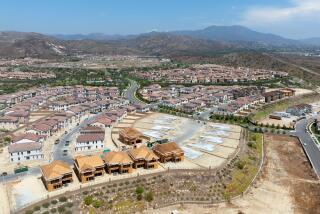S. California’s great migration
According to the latest census data, there’s been a great migration in Southern California over the last decade -- a movement that has pulled people from Los Angeles and Orange counties and transplanted them in the Inland Empire. Many moved for the jobs, especially in the booming housing construction industry; others moved to grab one of those houses as prices closer to the ocean soared beyond reach. Working-class and immigrant families sought affordable housing in less crowded communities where schools would be better and neighborhoods safer.
As a result, the populations in Los Angeles, Long Beach and other large cities in Los Angeles and Orange counties dropped. So did the number of nonwhite children, a trend that defied the pattern throughout the rest of the nation. Meanwhile, the number of immigrants, mostly Latino, in Riverside and San Bernardino counties leaped during the boom years. From 2000 to 2007, the number of immigrants in the Inland Empire rose by more than half. The change was so abrupt that many schools in that region struggled to provide services for students who were not fluent in English, an issue they had not grappled with before.
With the housing market’s sharp downturn and the flailing economy, things haven’t worked out for many of us as we’d planned. But it’s safe to say that this is especially true of the people who took their American dreams to the Inland Empire. Real estate prices there fell more sharply -- by half -- and the jobless rate, at 14.8%, is higher than in neighboring counties.
Those two trends were even more closely related in the Inland Empire than in most areas of California: Many of the region’s jobs, and by far the biggest portion of its job losses, were related to construction. Many families were unable to afford their mortgages. Several of the newer housing developments became foreclosure ghost towns.
The quick rise and fall of the Inland Empire -- which already shows the first signs of recovery -- has thrown into sharp relief a longstanding truth about Southern California’s growth pattern: Its dependence on cars, its sprawl and the lack of regional planning create an unwieldy hodgepodge of housing and jobs that make its residents too vulnerable to shifts in the economy.
Of course, poorly planned sprawl has served the entire region badly. It adds yet more cars to the freeway system; efforts to provide public transportation have been limited, and sometimes for good reason. With no single centralized location where most jobs are found, it’s hard to build a system that can take enough workers where they need to go. Long commutes add to long workdays and contribute to pollution, global warming and dependence on foreign oil. Not to mention gas prices well above $4 a gallon at the moment.
Many Southern Californians have long drives to work, but the average commute of Inland Empire residents is significantly longer, according to census data released in 2009. About a third of residents commute outside the region -- mostly to Los Angeles and Orange counties. And, according to the University of Redlands, only about 5% use public transit. Eighty percent drive solo.
People tend to commute farther in bad times. They may have picked their house in part to be close to work, but what happens if they lose that job? Without a centralized employment hub for the region, their new job might be at any distance, in almost any direction. As hard as it is to find a job, it’s even harder to sell a house and uproot a family. So most people stay put.
Sprawl makes even the region’s wildfires more devastating because most of the available land for large-scale development is near wilderness areas once considered remote.
For many Latino families who moved to the Inland Empire, the change was isolating as well. They were separated from neighborhoods that provided social opportunities and businesses that catered to their needs. The switch to the suburbs was especially problematic for new residents who found themselves suddenly jobless -- by late 2010, the poverty rate in the Inland Empire had grown more than almost anywhere in the nation. Yet there were fewer social services.
Though the overall trend of the last decade was toward the Inland Empire, the troubles these residents encountered were so dire that, by mid-2009, there were the first signs of reverse migration -- growth of ethnic minority populations slowed there and began rebounding in such gateway cities as L.A. Demographers theorize that some were moving back to be closer to social networks and support services.
But families need more. They need affordable housing, safe communities, decent schools and open space in the form of neighborhood parks. And, of course, jobs.
These are issues worth pondering as Southern California begins the process of pulling itself out of the recession. With housing starts up slightly in the Inland Empire, officials there have a chance to insist that any new construction must be contingent on adequate public transit, water, energy and other infrastructure for sustainable growth -- and to encourage denser, infill development rather than construction in the hinterlands, where commutes are tougher and wildfires more of a danger. And officials in the coastal counties must figure out how to provide the schools and housing that enable families to stay there.
The state sadly missed out in 2008 on an opportunity to encourage such steps when two bills that provided incentives for smarter planning never became law. One floundered in the Legislature; the other was vetoed by former Gov. Arnold Schwarzenegger. The halting recovery of the economy offers another chance at this.
More to Read
Sign up for Essential California
The most important California stories and recommendations in your inbox every morning.
You may occasionally receive promotional content from the Los Angeles Times.










